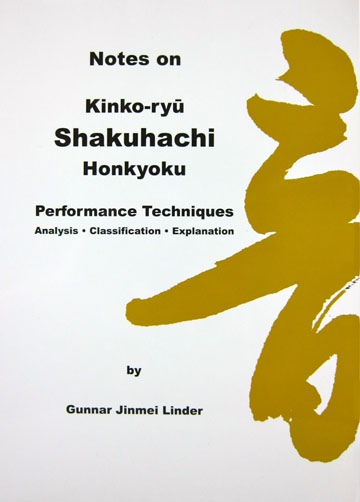
Gunnar Jinmei Linder
Notes on
Kinko-ryu Shakuhachi Honkyoku
Performance • Techniques
Analysis • Classification • Explanation
English Language
![]()
![]()
![]()
I3 CDs
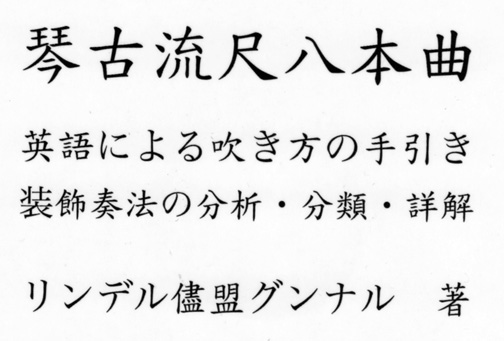
 |
Gunnar Jinmei Linder Notes on Performance • Techniques Analysis • Classification • Explanation English Language I3 CDs |
|
This English-language volume is a detailed guide for intermediate to advanced students, who wish to thoroughly study Kinko-ryu honkyoku. The book is divided in two main chapters. The first chapter contains three parts: Part 1: A theoretical discussion of ornaments and their definitions, as well as division of pieces and phrases in smaller units. Part 2: Some remarks about rhythm and notation. Part 3: 55 pages include detailed explanations of the ornamental techniques used in Kinko-ryu honkyoku. There is also a Quick Reference Guide at the end of the book covering the basic terminology used. The second chapter is one-hundred and twenty-four pages in length and consists of detailed, phrase-by-phrase explanations of ten the Kinko-ryu honkyoku pieces listed below. The book comes with three CDs that include recordings of all ten pieces. There are fold-out scores at the end of the book, made especially for this edition, in beautiful easy-to-read calligraphy. The scores are based on the Miura Kindo notation, but auxiliary explanations and superfluous repetition marks in the original Miura notation have been excluded to make the scores easier to read. Each phrase is numbered in the scores and in the explanations, in order to make it easy to locate a certain phrase. The book is bound with a spiral ring to keep the pages to stay open when playing. The spiral ring also facilitates flipping the pages with one hand. There is an appendix with Fingerings Charts, a Quick Reference Guide to ornaments, and Fold-out Scores for the pieces covered.
What People Say About This Book "Shakuhachi honkyoku appeal to musicians and music lovers around the world due to their simplicity and expression of the all within a single tone: each utterance of sound becomes a microcosm of universal music. Honkyoku, however, come in many styles-some are simple meditations on repetitive tones and others tend toward a higher degree of musical sophistication. Of all the shakuhachi honkyoku, those of the Kinko attain a special musical beauty- through a complicated and highly refined series of ornamentations. Mastery of these honkyoku ornamentations requires years of training in the balance of tone color, timing, volume, fingering and breath control. This training is achievable only through repetition and hands-on learning. Indeed, the normal way one learns these pieces in Japan is to sit at the feet of a master for years, patiently imitating the music and taking in that which is transmitted non-verbally between teacher and student. "This kind of "silent transmission" can be vastly augmented, however, by a sharp intellect and detailed musical analysis of what is actually going on in the music. Gunnar Jinmei Linder has achieved exactly this with Notes on Kinko-ryu Shakuhachi Honkyoku, guiding the reader through a selected number of Kinko-ryu shakuhachi honkyoku. Each phrase and its ornamentation, as learned from Yamaguchi Goro, are carefully analyzed and explained in a step by step description, and the corresponding notation is well marked and made easy to read. Linder also provides recordings of each piece, where one can easily discern the details of the ornamentation. "Books or recordings will never replace the experience of one on one learning, but in this book Linder, as one of only two foreigners who received a shihan license from Yamaguchi, provides a wealth of knowledge for shakuhachi students, ethnomusicologists and composers' who are trying to appreciate and understand the delicate, refined ornamentations of Yamaguchi's interpretations of the Kinko honkyoku. I cannot think of any other example of such accurate and detailed explanations of honkyoku, and I am certain that this volume will be an important addition to the library of any shakuhachi player or scholar." Christopher Yohmei Blasdel - Shakuhachi Shihan, Chikumeisha 232 pages PG-23 |
|||||||||||||||||||||||||
Gunnar Jinmei Linder began studying with shakuhachi master, Living National Treasure Yamaguchi Goro (1933–1999) in 1985. He has continued within the guild of Yamaguchi-sensei (Chikumeisha). He is a council of the organization, and head of the guild’s European Branch. He graduated with an M.A. from the traditional music conservatoire at Tokyo National University of Fine Arts and Music (Tokyo Geidai) in 1997, and received his shihan licence in 1998. Linder has been active extensively, both in Japan and other countries, as a performer and teacher, and as a lecturer on shakuhachi and traditional Japanese music. Gunnar moved back to Sweden in 2005, and continues his shakuhachi activities in Europe. He is also working as lecturer at Stockholm University, Department of Japanese Studies, besides conducting research in the field of Japanese traditional arts. |
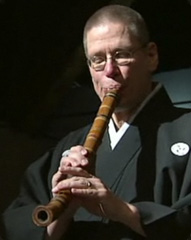 |
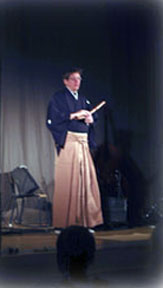 |
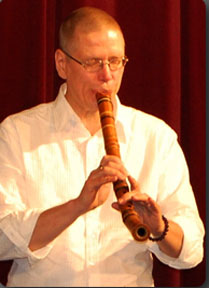 |
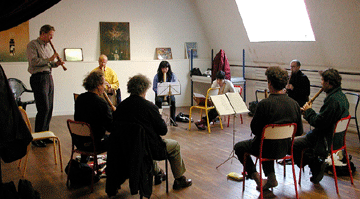 |
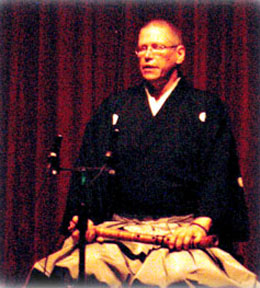 |
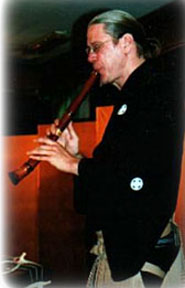 |
Learn More About Gunnar Jinmei Linder |
| Price of Book | Ordering Information |